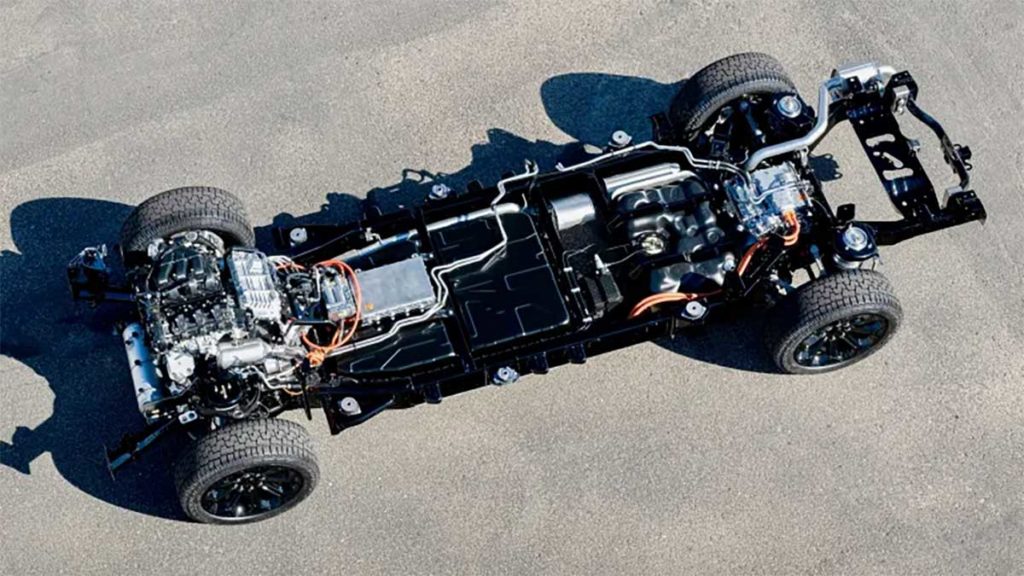Stellantis has just unveiled its latest new multi-energy platform, the STLA Frame. After presenting its platforms STLA Medium and STLA LargeThis third evolution marks a turning point in the company's strategy, especially for North American markets and other regions where large pick-ups and SUVs are king. Dedicated to electric, hybrid, hydrogen and internal combustion engine vehicles, the STLA Frame proclaims its versatility.
A platform designed for the future of pick-ups and SUVs

The STLA Frame is a native BEV (Battery Electric Vehicle) platform, but its modular design enables it to integrate a wide range of technologies. Above all, it's an architecture designed for large pick-ups and SUVs, growing segments in the United States, but also for global markets where demand for these vehicles remains strong.
With an impressive towing capacity of 6,350 kg, a payload of 1,224 kg and ranges from 800 km for pure electric vehicles (BEV) to 1,100 km for extended-range models (REEV), the STLA Frame aims to rival the best current platforms.
One of the STLA Frame's main selling points is its range. BEV versions of the platform reach up to 800 km, while the REEV versions, equipped with an internal combustion engine generator, extend this distance to 1,100 km.This combines the benefits of electrification with the ability to drive long distances without worrying about range. Thanks to batteries ranging from 159 kWh to over 200 kWh and a fast-charging system capable of adding 100 miles (160 km) in 10 minutes via a 350 kW charger, the platform addresses one of the biggest challenges facing electric vehicles: recharging time.
Multi-energy compatible

STLA Frame is designed forr accept a wide variety of propulsion technologies. In addition to BEV and REEV versions, the platform is also ready to accommodate internal combustion engines, hybrids and hydrogen engines in the future. This flexibility will enable Stellantis to meet the diverse needs of consumers, particularly those who, in search of power or longevity, are still hesitating to take the step towards electrification.

Electrically propelled vehicles are equipped with front and rear electric drive modules (EDMs), offering all-wheel drive. These motors enable acceleration from 0 to 100 km/h in just 4.4 seconds, offering exceptional performance in terms of torque and responsiveness.
Robust design

Stellantis has focused on safety, durability and energy efficiency in the design of the STLA Frame. Using high-strength steel, the platform is designed to offer increased rigidity while reducing weight. An essential element of the design is the enlarged central section, designed to house the batteries. A reinforced chassis protects the batteries in the event of a side impact, while a protective casing reduces aerodynamic drag, optimizing the vehicle's range.
The architecture allows ground clearance of between 168 and 262 mm, and the vehicles are capable of crossing fords of 610 mm, a perfect specification for SUVs and off-road pick-ups.
Fast, two-way charging
STLA Frame for fast battery rechargingbut also to supply power to other vehicles or even houses in the event of an emergency. This bi-directional charging function enables the vehicle's battery to become an energy source, powering other electric vehicles, a household or even a grid.
Fast charging is another of the platform's strong points. The BEV version benefits from fast 800-volt DC charging, capable of delivering up to 350 kW, adding 100 miles (160 km) of range in just 10 minutes. As for the REEV, a charge of 175 kW in 10 minutes adds a further 50 miles (80 km) to the range.
Our opinion on STLA Frame
With the introduction of the STLA Frame, Stellantis continues its ambitious electrification strategy as part of the Dare Forward 2030. While the STLA Frame platform appears to be aimed primarily at the United States, there are a number of aspects to consider. The weight of this platform, with its reinforced steel and batteries ranging from 159 to 200 kWh, could prove a challenge. Indeed, vehicles equipped with 100 kWh batteries already weigh at least 2.2 tonnes, which raises the question of how these heavy vehicles will be perceived by the market, especially in terms of performance and energy efficiency.
By way of comparison, the new Tesla Cybertruck comes with a 123 kWh battery in base version, with an option to increase this capacity by a further 50 kWh, in order to maintain weighing in at 3 tonnes and a reasonable selling price. Incidentally, Tesla's battery capacity has disappointed some interested parties, as, although the claimed range is 547 km (340 miles), it appears to be less than that of some competitors. While a Stellantis vehicle with a 159 kWh to 200 kWh battery will surely be heavy and expensive, it's important to stress that at this stage, these considerations remain theoretical until the first vehicle equipped with this platform is released. on the new RAM 1500 electric, the advertised range is 350 miles (560 km) with the "small" battery and 500 miles (800 km) with the large battery, available in 2026.
Another area to keep an eye on is REEV technology. Although it offers a range of 1,100 km, which sounds impressive, Xpeng recently unveiled a REEV technology capable of providing 1,400 km of autonomy. Stellantis will therefore have to ensure that it remains competitive with automotive giants such as Tesla and Xpeng, who are already well established and whose offerings are equally ambitious.
Do you know if this platform is compatible with Ducato/Boxer/Jumper vans, etc.? Their replacement is becoming a matter of urgency, and the latest restyling isn't enough to hide its age (20 years soon...) in the face of much more modern competition (Master among others...).